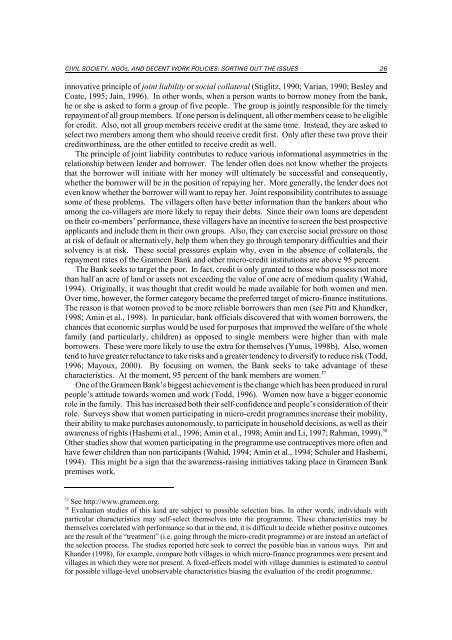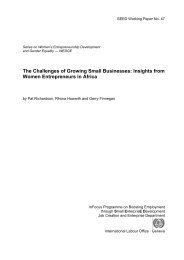Civil Society, NGOs, and Decent Work Policies: Sorting out the Issues
Civil Society, NGOs, and Decent Work Policies: Sorting out the Issues
Civil Society, NGOs, and Decent Work Policies: Sorting out the Issues
You also want an ePaper? Increase the reach of your titles
YUMPU automatically turns print PDFs into web optimized ePapers that Google loves.
CIVIL SOCIETY, NGOS, AND DECENT WORK POLICIES: SORTING OUT THE ISSUES 26<br />
innovative principle of joint liability or social collateral (Stiglitz, 1990; Varian, 1990; Besley <strong>and</strong><br />
Coate, 1995; Jain, 1996). In o<strong>the</strong>r words, when a person wants to borrow money from <strong>the</strong> bank,<br />
he or she is asked to form a group of five people. The group is jointly responsible for <strong>the</strong> timely<br />
repayment of all group members. If one person is delinquent, all o<strong>the</strong>r members cease to be eligible<br />
for credit. Also, not all group members receive credit at <strong>the</strong> same time. Instead, <strong>the</strong>y are asked to<br />
select two members among <strong>the</strong>m who should receive credit first. Only after <strong>the</strong>se two prove <strong>the</strong>ir<br />
creditworthiness, are <strong>the</strong> o<strong>the</strong>r entitled to receive credit as well.<br />
The principle of joint liability contributes to reduce various informational asymmetries in <strong>the</strong><br />
relationship between lender <strong>and</strong> borrower. The lender often does not know whe<strong>the</strong>r <strong>the</strong> projects<br />
that <strong>the</strong> borrower will initiate with her money will ultimately be successful <strong>and</strong> consequently,<br />
whe<strong>the</strong>r <strong>the</strong> borrower will be in <strong>the</strong> position of repaying her. More generally, <strong>the</strong> lender does not<br />
even know whe<strong>the</strong>r <strong>the</strong> borrower will want to repay her. Joint responsibility contributes to assuage<br />
some of <strong>the</strong>se problems. The villagers often have better information than <strong>the</strong> bankers ab<strong>out</strong> who<br />
among <strong>the</strong> co-villagers are more likely to repay <strong>the</strong>ir debts. Since <strong>the</strong>ir own loans are dependent<br />
on <strong>the</strong>ir co-members’ performance, <strong>the</strong>se villagers have an incentive to screen <strong>the</strong> best prospective<br />
applicants <strong>and</strong> include <strong>the</strong>m in <strong>the</strong>ir own groups. Also, <strong>the</strong>y can exercise social pressure on those<br />
at risk of default or alternatively, help <strong>the</strong>m when <strong>the</strong>y go through temporary difficulties <strong>and</strong> <strong>the</strong>ir<br />
solvency is at risk. These social pressures explain why, even in <strong>the</strong> absence of collaterals, <strong>the</strong><br />
repayment rates of <strong>the</strong> Grameen Bank <strong>and</strong> o<strong>the</strong>r micro-credit institutions are above 95 percent.<br />
The Bank seeks to target <strong>the</strong> poor. In fact, credit is only granted to those who possess not more<br />
than half an acre of l<strong>and</strong> or assets not exceeding <strong>the</strong> value of one acre of medium quality (Wahid,<br />
1994). Originally, it was thought that credit would be made available for both women <strong>and</strong> men.<br />
Over time, however, <strong>the</strong> former category became <strong>the</strong> preferred target of micro-finance institutions.<br />
The reason is that women proved to be more reliable borrowers than men (see Pitt <strong>and</strong> Kh<strong>and</strong>ker,<br />
1998; Amin et al., 1998). In particular, bank officials discovered that with women borrowers, <strong>the</strong><br />
chances that economic surplus would be used for purposes that improved <strong>the</strong> welfare of <strong>the</strong> whole<br />
family (<strong>and</strong> particularly, children) as opposed to single members were higher than with male<br />
borrowers. These were more likely to use <strong>the</strong> extra for <strong>the</strong>mselves (Yunus, 1998b). Also, women<br />
tend to have greater reluctance to take risks <strong>and</strong> a greater tendency to diversify to reduce risk (Todd,<br />
1996; Mayoux, 2000). By focusing on women, <strong>the</strong> Bank seeks to take advantage of <strong>the</strong>se<br />
characteristics. At <strong>the</strong> moment, 95 percent of <strong>the</strong> bank members are women. 37<br />
One of <strong>the</strong> Grameen Bank’s biggest achievement is <strong>the</strong> change which has been produced in rural<br />
people’s attitude towards women <strong>and</strong> work (Todd, 1996). Women now have a bigger economic<br />
role in <strong>the</strong> family. This has increased both <strong>the</strong>ir self-confidence <strong>and</strong> people’s consideration of <strong>the</strong>ir<br />
role. Surveys show that women participating in micro-credit programmes increase <strong>the</strong>ir mobility,<br />
<strong>the</strong>ir ability to make purchases autonomously, to participate in household decisions, as well as <strong>the</strong>ir<br />
awareness of rights (Hashemi et al., 1996; Amin et al., 1998; Amin <strong>and</strong> Li, 1997; Rahman, 1999). 38<br />
O<strong>the</strong>r studies show that women participating in <strong>the</strong> programme use contraceptives more often <strong>and</strong><br />
have fewer children than non participants (Wahid, 1994; Amin et al., 1994; Schuler <strong>and</strong> Hashemi,<br />
1994). This might be a sign that <strong>the</strong> awareness-raising initiatives taking place in Grameen Bank<br />
premises work.<br />
37<br />
See http://www.grameen.org.<br />
38<br />
Evaluation studies of this kind are subject to possible selection bias. In o<strong>the</strong>r words, individuals with<br />
particular characteristics may self-select <strong>the</strong>mselves into <strong>the</strong> programme. These characteristics may be<br />
<strong>the</strong>mselves correlated with performance so that in <strong>the</strong> end, it is difficult to decide whe<strong>the</strong>r positive <strong>out</strong>comes<br />
are <strong>the</strong> result of <strong>the</strong> “treatment” (i.e. going through <strong>the</strong> micro-credit programme) or are instead an artefact of<br />
<strong>the</strong> selection process. The studies reported here seek to correct <strong>the</strong> possible bias in various ways. Pitt <strong>and</strong><br />
Kh<strong>and</strong>er (1998), for example, compare both villages in which micro-finance programmes were present <strong>and</strong><br />
villages in which <strong>the</strong>y were not present. A fixed-effects model with village dummies is estimated to control<br />
for possible village-level unobservable characteristics biasing <strong>the</strong> evaluation of <strong>the</strong> credit programme.
















